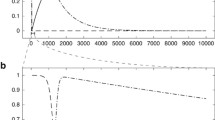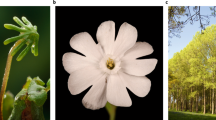Abstract
It is widely believed that plastid and mitochondrial genomes are inherited through the maternal parent. In plants, however, paternal transmission of these genomes is frequently observed, especially for the plastid genome. A male gametic trait, called potential biparental plastid inheritance (PBPI), occurs in up to 20% of angiosperm genera, implying a strong tendency for plastid transmission from the male lineage. Why do plants receive organelles from the male parents? Are there clues in plastids that will help to elucidate the evolution of plants? Reconstruction of the ancestral state of plastid inheritance patterns in a phylogenetic context provides insights into these questions. In particular, a recent report demonstrated the unilateral occurrence of PBPI in angiosperms. This result implies that nuclear cytoplasmic conflicts, a basic driving force for altering the mode of organelle inheritance, might have arisen specifically in angiosperms. Based on existing evidence, it is likely that biparental inheritance may have occurred to rescue angiosperm species with defective plastids.




Similar content being viewed by others
References
Angiosperm Phylogeny Group (2003) An update of the Angiosperm Phylogeny Group classification for the orders and families of flowering plants: APG II. Bot J Linn Soc 141:399–436
Baur E (1909) Das Wesen und die Erblichkeitsverhältnisse der ‘arietates albomarginatae hort’ von Pelargonium zonale. Z Indukt Abstammungs-Vererbungsl 1:330–351
Birky CW Jr (1995) Uniparental inheritance of mitochondrial and chloroplast genes: mechanisms and evolution. Proc Natl Acad Sci USA 92:11331–11338
Bock R (2000) Sense from nonsense: how the genetic information of chloroplasts is altered by RNA editing. Biochimie 82:549–557
Bock R, Kossel H, Maliga P (1994) Introduction of a heterologous editing site into the tobacco plastid genome: the lack of RNA editing leads to a mutant phenotype. EMBO J 13:4623–4628
Bogdanova VS (2007) Inheritance of organelle DNA markers in a pea cross associated with nuclear-cytoplasmic incompatibility. Theor Appl Genet 114:333–339
Chiu WL, Sears BB (1993) Plastome–genome interactions affect plastid transmission in Oenothera. Genetics 133:989–997
Collins EJ (1922) Variegation and its inheritance in Chlorophytum elatum and C. comosum. J Genet 12:1–17
Correns C (1909) Vererbungsversuche mit blass(gelb)grünen und buntblättrigen sippen bei Mirabilis jalapa, Urtica pilulifera und Lunaria annua. Z Indukt Abstammungs-Vererbungsl 1:291–329
Corriveau JL, Coleman AW (1988) Rapid screening method to detect potential biparental inheritance of plastid DNA and results for over 200 angiosperms. Am J Bot 75:1443–1458
Dyall SD, Brown MT, Johnson PJ (2004) Ancient invasions: from endosymbionts to organelles. Science 304:253–257
Fauré S, Noyer JL, Carreel F, Horry JP, Bakry F, Lanaud C (1994) Maternal inheritance of chloroplast genome and paternal inheritance of mitochondria genome in bananas (Musa acuminate). Curr Genet 25:265–269
Freyer R, Kiefer-Meyer MC, Kossel H (1997) Occurrence of plastid RNA editing in all major lineages of land plants. Proc Natl Acad Sci USA 94:6285–6290
Gastony GJ, Yatskievych G (1992) Maternal inheritance of the chloroplast and mitochondrial genomes in cheilanthoid ferns. Am J Bot 79:716–722
Guillon JM, Raquin C (2000) Maternal inheritance of chloroplasts in the horsetail Equisetum variegatum (Schleich.). Curr Genet 37:53–56
Hagemann R, Schröder MB (1989) The cytological basis of the plastid inheritance in angiosperms. Protoplasma 152:57–64
Havey MJ (1997) Predominant paternal transmission of the mitochondrial genome in cucumber. J Hered 88:232–235
Havey MJ, McCreight J, Rhodes B, Taurick G (1998) Differential transmission of the cucurbit organellar genomes. Theor Appl Genet 97:122–128
Hu YC, Zhang Q, Rao GY, Sodmergen (2008) Occurrence of plastids in the sperm cells of Caprifoliaceae: biparental plastid inheritance in angiosperms is unilaterally derived from maternal inheritance. Plant Cell Physiol 49:958–968
Hurst LD, Atlan A, Bengtsson BO (1996) Genetic conflicts. Q Rev Biol 71:317–364
Kuroiwa T (1991) The replication, differentiation, and inheritance of plastids with emphasis on the concept of organelle nuclei. Int Rev Cytol 128:1–62
Kuroiwa T, Kawano S, Nishibayashi S, Sato C (1982) Epifluorescent microscopic evidence for maternal inheritance of chloroplast DNA. Nature 198:481–483
Liu Y, Cui HX, Zhang Q, Sodmergen (2004) Divergent potentials for cytoplasmic inheritance within the genus Syringa. a new trait associated with speciogenesis. Plant Physiol 136:2762–2770
Maier RM, Zeltz P, Kossel H, Bonnard G, Gualberto JM, Grienenberger JM (1996) RNA editing in plant mitochondria and chloroplasts. Plant Mol Biol 32:343–365
Mambo E, Gao X, Cohen Y, Guo Z, Talalay P, Sidransky D (2003) Electrophile and oxidant damage of mitochondrial DNA leading to rapid evolution of homoplasmic mutations. Proc Natl Acad Sci USA 100:1838–1843
Martin W, Herrmann RG (1998) Gene transfer from organelles to the nucleus: how much, what happens, and why? Plant Physiol 118:9–17
Medgyesy P, Pay A, Marton L (1986) Transmission of paternal chloroplasts in Nicotiana. Mol Gen Genet 204:195–198
Miyamura S, Nagata T, Kuroiwa T (1987) Quantitative fluorescence microscopy on dynamic changes of plastid nucleoids during wheat development. Protoplasma 133:66–72
Mogensen HL (1996) The hows and whys of cytoplasmic inheritance in seed plants. Am J Bot 83:383–404
Nagata N, Saito C, Sakai A, Kuroiwa H, Kuroiwa T (1999) The selective increase or decrease of organellar DNA in generative cells just after pollen mitosis one controls cytoplasmic inheritance. Planta 209:53–65
Natcheva R, Cronberg N (2007) Maternal transmission of cytoplasmic DNA in interspecific hybrids of peat mosses, Sphagnum (Bryophyta). J Evol Biol 20:1613–1616
Nishimura Y, Misumi O, Matsunaga S, Higashiyama T, Yokota A, Kuroiwa T (1999) The active digestion of uniparental chloroplast DNA in a single zygote of Chlamydomonas reinhardtii is revealed by using the optical tweezer. Proc Natl Acad Sci USA 96:12577–12582
Pacak A, Szweykowska-Kulińska Z (2003) Organellar inheritance in liverworts: an example of Pellia borealis. J Mol Evol 56:11–17
Pandey KK, Blaydes GW (1957) Cytoplasmic inheritance of plastids in Impatiens sultanii F., Petunia violacea Lindl. and Chlorophytum elatum. Ohio J Sci 57:135–147
Peltier J, Friso G, Kalume D, Roepstorff P, Nilsson F, Adamska I, van Wijk K (2000) Proteomics of the chloroplast: systematic identification and targeting analysis of lumenal and peripheral thylakoid proteins. Plant Cell 12:319–341
Schmitz-Linneweber C, Kushnir S, Babiychuk E, Poltnigg P, Herrmann RG, Maier RM (2005) Pigment deficiency in nightshade/tobacco cybrids is caused by the failure to edit the plastid ATPase a-subunit mRNA. Plant Cell 17:1815–1828
Sterrer W (2002) On the origin of sex as vaccination. J Theor Biol 216:387–396
Wikström N, Savolainen V, Chase MW (2001) Evolution of the angiosperms: calibrating the family tree. Proc R Soc Lond B Biol Sci 268:2211–2220
Xu JP (2004) The prevalence and evolution of sex in microorganisms. Genome 47:775–780
Zhang Q, Liu Y, Sodmergen (2003) Examination of the cytoplasmic DNA in male reproductive cells to determine the potential for cytoplasmic inheritance in 295 angiosperm species. Plant Cell Physiol 44:941–951
Acknowledgments
This work was supported by the National Natural Science Foundation of China (Creative Research Group Program, no. 30421004; Key Program, no. 30430040) and the National Basic Research Program of China (Program 973, no. 2007CB108700).
Author information
Authors and Affiliations
Corresponding author
Rights and permissions
About this article
Cite this article
Zhang, Q., Sodmergen Why does biparental plastid inheritance revive in angiosperms?. J Plant Res 123, 201–206 (2010). https://doi.org/10.1007/s10265-009-0291-z
Received:
Accepted:
Published:
Issue Date:
DOI: https://doi.org/10.1007/s10265-009-0291-z




